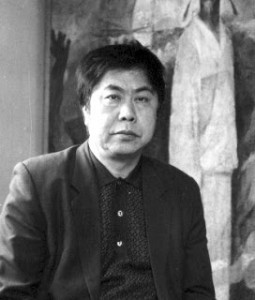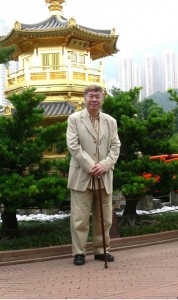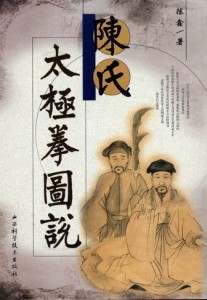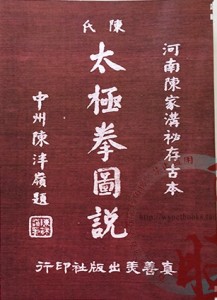A Brief Introduction of Taiji Master Wang Zhuanghong, by xiāo yáo shān rén.
信堅前言:
信堅園地從今起,增闢一欄: 逍遙太極,可見於 “太極拳” 標題下。此欄將專貼信堅的太極師父,逍遙山人,所寫的有關太極拳、劍、刀法、及其他武功創作。也將包括他以YouTube video 教導 和他學生的表演賽。 (去年奪得南加州太極表演賽冠軍)。這是他的第一篇文章。
一、引言
王壯弘宗師 (1931-2008) 堪稱近代太極拳泰斗級的巨人.其所創之水性太極拳可謂風華絕代、獨具一格。在太極拳演義的長河中, 水性太極實乃一顆新生的閃亮的金星。可以斷言, 他必將為太極拳的發展指明方向。幫助太極拳愛好者, 攀登绝頂高峰。逍遙山人雖然沒有見過王壯弘宗師,但是有幸跟隨其海外弟子張希榮及張雲義两位老師作過短期學習。對王氏水性太極稍知一二。日前吾友信堅大師在其《信堅園地》網站, 增闢太極拳一欄, 囑愚投稿。愚擬轉載王壯弘宗師為《陳式太極拳圖說》重印版所寫的序文, 與大家分享。愚亦將該文譯為英文, 以幫助只看英文的讀者。




二、《陳式太極拳圖說》重印版序 王壯弘
2.1 在我國多種多樣的拳術之中,太極拳可算是獨樹一幟,構思特異的拳種。一百多年前,陳長興的門人楊祿禪曾以此八門五步功夫,交遍當時名流好手。號稱「楊無敵」而譽滿拳壇,使後來拳界提起太極拳,無不肅然起敬。可見太極拳不但拳理巧妙,而且還具有非常強的技擊作用。
太極拳的原理,在陳氏《太極拳譜》、王宗岳《太極拳論》、《行功心解》,武禹襄、李亦畬等人的著述中,都有詳盡的論述。可惜這些經典著作沒有引起人足夠重視,有時甚至背道而馳。例如太極推手,應以不丟不頂為根本,而今推手之人都以拙力相待,意欲牢固其根,如牛之相抵,與太極以柔克剛之理相悖。豈知己根愈固,彼攻愈烈,自然之理也。粘黏連隨四勁,粘黏在手,連隨在步,根不去則步不靈活,人有攻擊目標,連隨無從,難免有跌倒之虞。故推手欲不跌倒先應去己之根。無根者,無固定之根也,如物飄於水,如球滾於地,猶如不倒翁,上欲輕、下欲重,即拳譜所云:「飄飄蕩蕩浪裡鑽,上輕下沉不倒顛」。
「太極」是個圓,不是平面圓,而是立體圓,四方八面都是一樣的圓,即十三勢中所謂四正四隅的八門。因此要求鬆肩沉肘,開胯擴膝,含胸拔背,使人形成一個有彈性的球體。不著力則罷,一著力即隨之旋轉,猶如皮球在地使人很難站立上去一樣。其靈活的程度猶如天秤,猶如轉輪。這就是拳譜所謂:「靜之則合,動之則分,立如秤準,活如車輪」。
然皮球是個無機物,人體是個有機物。人體不但具有類似皮球的功能,還有超過皮球的自重量,並具調節能力。只要恰當地運用粘黏連隨不丟頂的功夫即可使人進之不著,投之不脫。這就是十三勢中所謂進、退、顧、盼、定的五步。
人體的球形隨著開合還可大可小。此外全身主要關節也都具有圓轉能力,猶如許多小球。因此不但可大可小,而且可分可合。合則為一大球,分則為許多小球。因為太極拳的勁是仿效水性的,因此進退程式的要求是波浪式的連綿,即拳譜所謂「如長江大河,滔滔不絕」。並利用人體掌、臂、身、腿、腳,各部三個以上關節,互為一組交替進退。與對方的力一接觸,即起層層連鎖反應,似水浪般忽聚忽散動盪,加之螺旋式的八門旋轉(即陳鑫所謂的「纏絲勁」),如旋風、如捲浪,上升則高不可攀,下沉則深不可測;欲進則愈長,欲退則愈促。形成一種所謂「浪採花」的功夫,即拳譜所謂「仰之則彌高、俯之則彌深;進之則愈長,退之則愈促」。
太極拳的推手,在太極門中不過是一種鍛煉方式,是一個過程和階段,最後仍是散手。但太極拳的散手與其它拳的散手不同,亦與外間所傳的所謂「太極散手對打」不同。它是在推手至十分純熟的基礎上產生的一種可粘可脫、隨粘隨脫,身手雖脫意尚相接的方法,以槓桿、螺旋原理,以膨脹力和類似波浪的衝擊力,將人擊出去。性質雖然是柔軟的,但威力無比,即拳譜所謂「極柔軟則極堅剛」。因為世界上最柔軟的是水、是風、是空氣,然而力量最強大的亦是水、風以及空氣的膨脹力。太極散手,溫和時可以使人毫無痛楚而翻跌絕妙;猛烈時亦可以使人如受巨浪的衝擊,五臟俱裂。有了這種功夫,才算是得到太極真髓。
2.2 太極拳主張以虛靈、鬆淨、靜謐的方法來修己。行功時。血管鬆弛,毛孔開張,骨骼順當,心氣平和,是一種運動量(氣血活動量)極大,消耗量極小的動功,是完全符合養身之道,也是防治慢性疾病恢復健康的良好手段。太極拳武則可以防身禦侮,克敵制勝;文則可以調氣養心,延年益壽。可謂習武而文在其中,是一種文武兼修的拳術。
太極拳不但拳理精邃,而且完全符合我國人民謙讓的美德。因為它克敵禦侮,是不主張主動出手的。你不動,我不動;你既動,我才動。你不打我,我絕不打你;你既打我,我就根據你打我的輕重快慢,反作用於你。我猶如蹺板、轉門、皮球,推得重回得重,推得慢回得輕,打擊得重彈跌得遠。種種反應都是由你攻擊的一方自己引起的,我只是保持我的重心和中心而已。但它也不是無所作為的一味被動,根據需要,有時也可因勢利導,有意識地加強其反作用力,引起層層波浪,甚至洶湧浪濤,使人淹沒其中。但這種主動是在被動的基礎上產生的,因此雖說主動,仍屬被動。
學習太極拳的方法應該以悟為主,學者不管從那一派太極入門,都不能以學會拳架為最終目標。必須進一步領悟其內的實質,並有所改進和提高,而對拳術有所貢獻。這就是古人常說的「得意忘象」的學習方法。具體的形象是為了幫助瞭解道理的,道理得到了,應該根據道理去創造更完美的形象,改造形象,事物就是這樣進步的。這亦是每個有志於拳術者應有的抱負。
2.3 目前流傳的各式太極拳中,以陳式最為古老,它是太極拳中最負盛名的一種。此拳創自陳家溝,陳氏第九世陳王廷,其父祖均好拳術。王廷,明末武痒生,曾任溫縣鄉兵守備,明亡後隱居鄉間。嘗自謂:「……年老殘喘,只落得《黃庭》一卷隨身伴,悶來造拳,忙來時耕田。」《黃庭》即《黃庭經》,傳世有七字句本,八字句本,尚有《黃庭內景經》,內容不亦不盡相同,但都是道家導引吐納養身之術。陳王廷參考《黃庭》造拳,必定是符合其晚年修心養身,又不意武事的心情。嗣後此拳陳式世代相傳,亦有新的改進和提高。代表人物有陳長興(1771~1853)、陳青萍(1795~1868)、陳鑫(1849~1929)和陳發科(1887~1957)。陳長興曾傳楊祿禪,陳青萍曾傳武禹襄,陳長興曾孫陳發科日練拳三十遍,功力純厚,是近代陳式老架的代表人物。而陳鑫文武兼備,發奮著書立說,首次用文字總結了歷代陳式太極拳的練拳經驗。其所著的《太極拳圖說》對螺旋式的纏絲勁路、全身經絡、以及無極生太極、太極生二儀、二儀生四象、四象生八卦,陰陽消長等原理,闡發詳盡。以易理說拳理,圖文並茂。學者由此循進,最易領悟太極奧義。
今上海書店擇善本重加影印,編輯同志要我寫一篇序,由於學識淺薄、文筆滯澀,未能詳論,就寫這些粗淺的體會和感想吧。1985年3月於上海
_______________
“Chen-style Taichichuan with Graphic Illustration” Preface for the reprinting edition By Wang Drong-Hung Shanghai, China, March 1985
Among the numerous martial art systems in China, Taichichuan is a unique branch based on non-ordinary concepts. Over one hundred years ago, Chen Chang-Shin’s disciple, Yang Lu-Chan, made use of Taichichuan’s eight-gate and five-step kung fu in engaging other masters, which earned him “Champion Yang” in the martial art community. This has demonstrated to us that Taichichuan offers strong martial capability, not just something with sophisticated theories.
The fundamental principles of Taichichuan have been discussed in details in many writings by grandmasters, including Chen Shin, Wang Chung-Yueh, Wu Yu-Shiang, Li Yi-Hseh, and others. However, these classics have not received enough attention from most people. Furthermore, some practitioners even follow an opposite direction.
Let us consider Push Hand as an example. Push Hand should be executed on the basis of “neither separate nor against.” But today, most people do use “blunt force,” hoping to strengthen his roots. They behave like bull fight. This is against the call of Taichichuan for using softness to deal with hardness. It’s a natural principle to realize that the more I strengthen my roots, the harder he would push me.
Fundamental principles in Push Hand can be highlighted in terms of four key elements: touch up, stick to, connect with, and follow through. The first two are meant for hand maneuvers while the latter two are meant for step functions of feet. If one does not de-root, he won’t be able to step around swiftly and freely. He could not perform “connect with” and “follow through,” thereby presenting himself as a target for attack, which leads to the possibility of falling down. Therefore, in order to avoid falling down in Push Hand, one must at first de-root him. Actually, de-root means “without fixed root,” much like an object floating on water or a sphere rolling on ground. It is also analogous to a toy with light top and heavy bottom with a never falling stability.
The concept of “Taichi” is circle. But it is not a planner concept; rather, it is a spherical concept. It is envisioned as a circle viewed from all directions. This concept is referred to the so-called eight gates, which includes four normal and four oblique orientations, and is a subset of the 13 postures. Manifested in terms of specific execution, this calls for requirements in loosening the shoulders and sinking the elbows; opening the qua and expanding the knees; and contending the chest and stretching the back. One would behave like an elastic sphere. This sphere would then rotate under any external force action. Think about a sphere resting on the ground. Would it be difficult for you to get on top of it? The degree of freedom is similar to a balance measure, or to a rotating wheel. The discussion here has been introduced in the classics as “stillness leads to close; motion leads to open; standing is like a balance measure; move around is like a rotating wheel.”
But a sphere is an inorganic object while a man is an organic entity. There are major differences between the two. In addition to similar capability of the sphere, a man is able to make further adjustments of his center of gravity. With proper use of the sticking kung fu (touch up, stick to, connect with, follow through, never allow separation, and never go against anything) one would neither offer a point of contact for the approaching attacker to exert his force, nor allow the attacker to toss him away. This capability is the so-called five steps, i.e., advance, retreat, leftward, rightward, and centralization. This is the other subset of the 13 postures.
Man’s conceptual sphere could be made large or small according to his intent in opening or closing. Major joints in the human body behave like many small spheres, able to rotate, able to vary in size, and able to open or close. When they open, they become many small spheres. When they close, they combine into a large sphere.
Taichichuan’s Jin follows the characteristics of water. Therefore, the process of generating Jin should exhibit the propagation of water waves. This idea has been introduced in the classics by saying “like continuous water waves in the great river of Yangtze.” The propagation process of Jin calls for the connectivity of body joints linking palm, arm, torso, leg, and foot. Each wave segment covers a section of the body, which consists of three or more joints.
As soon as an external force is exerted upon your body, you just initiate a chain reaction of water waves, which moves around in a divergent or convergent manner. You can also add silk-reeling Jin on the waves. The overall result is much like tornado or big ocean waves. In this case, it is not possible to know how high you rise up to if you go up; or, how deep you are if you sink down. Similarly, you can always follow closely with the attacker’s pace in advancement or retreat. The essence can be called “wave carries flower,” and has been described clearly in classics.
Within the greater Taichi systems arena, Push Hand is but a form of training, a transitioning process and milestone. Eventually, it leads to Sanshou (free sparing). But, Taichichuan’s Sanshou is still different from that of other martial arts. One must first establish a solid Push-Hand foundation before he can do Sanshou. It involves both sticking and non-sticking techniques with a large degrees of freedom; sometimes sticking intent continues even though physical contact has ended in separation.
Taichichuan’s Sanshou technique calls for tossing out the opponent with using leverage and spiraling principles; together with using expansion power along with wave-like impact. Its basic nature is soft; but it generates immense power. The classics have described this property as saying, “First achieving extreme softness; then extreme hardness follows.”
Obviously, the softest substances on earth are water, wind, and air. And the most powerful strength also comes from water, wind, and the expansion power of air. This type of Sanshou, performed in a soft manner, can cause painless, amusing, and enjoyable effect. However, if performed in an aggressive manner, it can induce severe damage to inner organs. Without achieving this kung-fu level, one would still be considered a mediocre.
In terms of solo training, Taichichuan requires emptiness, stillness, and total relaxation. During a routine practice, one needs to incorporate a number of features, namely, relax the blood vessels, open the skin pores, align the bone structures, and still the mind. It is an exercise with large internal energy cultivation while with little physical power consumption. It is very suitable for enhancing health and promoting longevity. In addition, it is a good means for chronic-disease prevention and recovery. So, it is fare to say that Taichichuan is a unique exercise, serving both needs in health enhancement as well as in self-defense for martial interest.
Let us now discuss a bit more on the defense side. Taichichuan does not encourage one to initiate an attack. Rather, according to the quotation, “If you don’t move, I don’t move. Since you move first, I simply follow. If you don’t attack me, I’d never attack you. Since you initiated an attack on me, I just respond with a reactive measure based solely on the strength and speed of your attack.” A good analogy for my counter measure is the mechanism of seesaw, revolving door, or sphere. Reaction is directly proportional to action. Otherwise, I need to maintain my central equilibrium and center of gravity. However, there is an active measure imbedded within the passiveness. Whenever necessary, I could deliberately increase the reactive measure, causing a chain of waves to engulf the attacker. But this kind of activeness is originated from the basis of passiveness, qualifying it as a quasi activeness. The bottom line is passiveness.
What kind of attitude should one take in learning Taichichuan? The answer is: one should learn from enlightenment. Having learnt a routine is not the ultimate goal, regardless of the styles. One must continue to seek understanding of some deep and profound meanings and quality. Then one should try to make improvement, to raise its level, and to contribute to the advancement of the art. This is a learning method called by the ancestors as “when you have acquired Yi (intent), you can forget the external form.” Form is meant for providing assistance in understanding the theory. If you know the theory, you should create better form based on the theory. This is the basis for all things to make progress. I hope all martial artists embark on this aspiration. [Translator’s Remark: a third part of the original article has not been translated here because it covers history and lineage of the Chen style Taichichuan; information should be widely available elsewhere.]

那請問如果想學太極拳,有辦法看youtube上的太極拳影片然後自學嗎?想請問師兄有關於學太極拳的心得或是入門的方法?
最好先找一位好老師啟蒙。Youtube 裡有關練太極拳的影片,汗牛充棟。初學者難以分辨好壞,不知如何決擇。前賢曰: “入門引路須口授!” 前賢又曰: “學拳容易改拳難!” 能不慎乎?
另外,山人將與信堅合作, 陸續推出一些學練太極拳的心得。初期主要針對已有一定程度的朋友,然後循序漸進。
逍遙山人
Robert 師兄:
難得太極大師,逍遙山人,發心將一生所學太極拳的練拳心得與教學經驗,在此園地,與大家分享,真是三生有幸。也難得他又肯花時間,親自回覆問題,所說句句金言。以後張貼更多文章,自會了解其中深意。
打太極拳是一門深奧的武功,不是比手劃腳,依樣畫葫蘆。學者除了要緊隨師訓,熟練拳架外,更要精究練拳之心法和要領,多和同門切磋,研讀前賢之心得論著。學太極拳,有如修行證道,須有明師指點,信解行証。
當年信堅跟逍遙山人學 “混元太極” 時,一招一式慢慢練,慢慢修正姿勢心態,學完整套二十四式後,仍須一招一式,全神貫注,意到氣到的慢慢打。當時逍遙山人也同時送給我們一個CD (相當於現在的Youtube 影片),以慢動作,讓我們打拳時,能由此隨時注意姿勢意境。 因此,Youtube 影片,只是輔助教學而已。
太極大師逍遙山人此文,藉王狀弘宗師的序文,講說太極拳的原理與練太極拳的心法、要領。有了這基本認識,才能於太極拳架式中,領悟太極拳的精隨。
信堅於四年前,曾不自量力,將前賢所教,太極拳心法要領,集成 “太極拳真義” 一文,班門弄斧,一直沒有機會,請逍遙山人評論,現正是時。
信堅
信堅大師:
“太極拳真義” 一文,寫得好極了,句句都是經典。誠實的說, 意境太高了. 我只算瞭解一小部分,其餘的大部分內容,我只能猜想其中內涵。希望在不斷的實踐中,找到感覺。不過,即使似懂非懂,我仍喜歡背誦這些佳句。對我而言,這是一種享受。早年我亦草編過類似的短文,均未曾發表過。也許不久找空交流分享心得。
逍遙山人